tire size MAZDA MODEL 3 HATCHBACK 2020 (in English) User Guide
[x] Cancel search | Manufacturer: MAZDA, Model Year: 2020, Model line: MODEL 3 HATCHBACK, Model: MAZDA MODEL 3 HATCHBACK 2020Pages: 598, PDF Size: 89.37 MB
Page 360 of 598
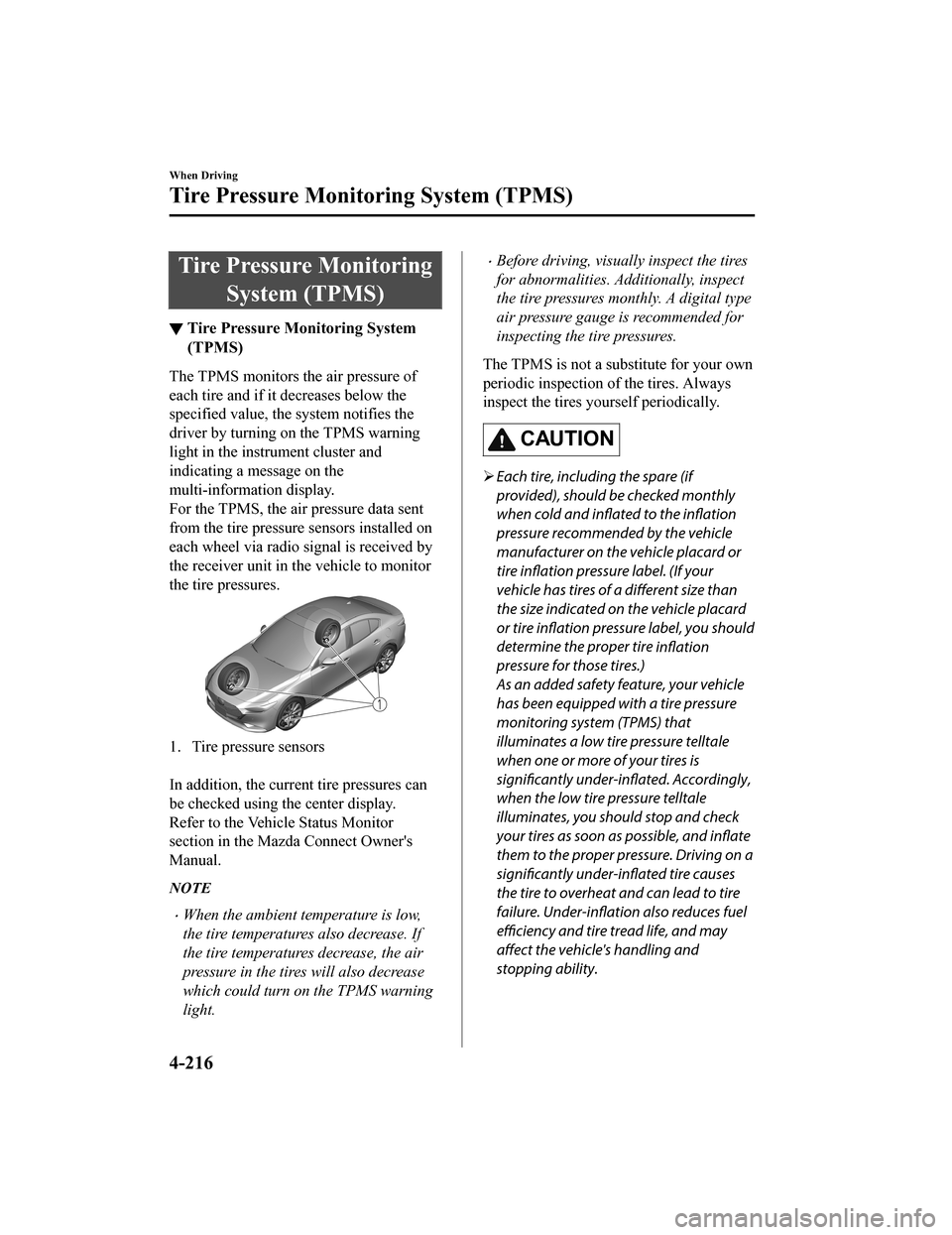
Tire Pressure MonitoringSystem (TPMS)
▼Tire Pressure Monitoring System
(TPMS)
The TPMS monitors the air pressure of
each tire and if it decreases below the
specified value, the system notifies the
driver by turning on the TPMS warning
light in the instrument cluster and
indicating a message on the
multi-information display.
For the TPMS, the air pressure data sent
from the tire pressure s
ensors installed on
each wheel via radio signal is received by
the receiver unit in t he vehicle to monitor
the tire pressures.
1. Tire pressure sensors
In addition, the current tire pressures can
be checked using the center display.
Refer to the Vehic le Status Monitor
section in the Mazda Connect Owner's
Manual.
NOTE
When the ambient temperature is low,
the tire temperatures also decrease. If
the tire temperatures decrease, the air
pressure in the tires will also decrease
which could turn on the TPMS warning
light.
Before driving, visually inspect the tires
for abnormalities. Additionally, inspect
the tire pressures monthly. A digital type
air pressure gauge is recommended for
inspecting the tire pressures.
The TPMS is not a substitute for your own
periodic inspection of the tires. Always
inspect the tires yourself periodically.
CAUTION
Each tire, includ ing the spare (if
provided), should be checked monthly
when cold and inflated to the
inflation
pressure recommended by the vehicle
manufacturer on the vehicle placard or
tire inflation pressure label. (If your
vehicle has tires of a different size than
the size indicated on the vehicle placard
or tire inflation pressure label, you should
determine the proper tire inflation
pressure for those tires.)
As an added safety feature, your vehicle
has been equipped with a tire pressure
monitoring system (TPMS) that
illuminates a low tire pressure telltale
when one or more of your tires is
significantly under-inflated. Accordingly,
when the low tire pressure telltale
illuminates, you should stop and check
your tires as soon as possible, and inflate
them to the proper pressure. Driving on a
significantly under-inflated tire causes
the tire to overheat and can lead to tire
failure. Under-inflation also reduces fuel
efficiency and tire tread life, and may
affect the vehicle's handling and
stopping ability.
When Driving
Tire Pressure Monitoring System (TPMS)
4-216
Mazda3_8HZ1-EA-19G_Edition1_old 2019-5-17 13:49:03
Page 463 of 598
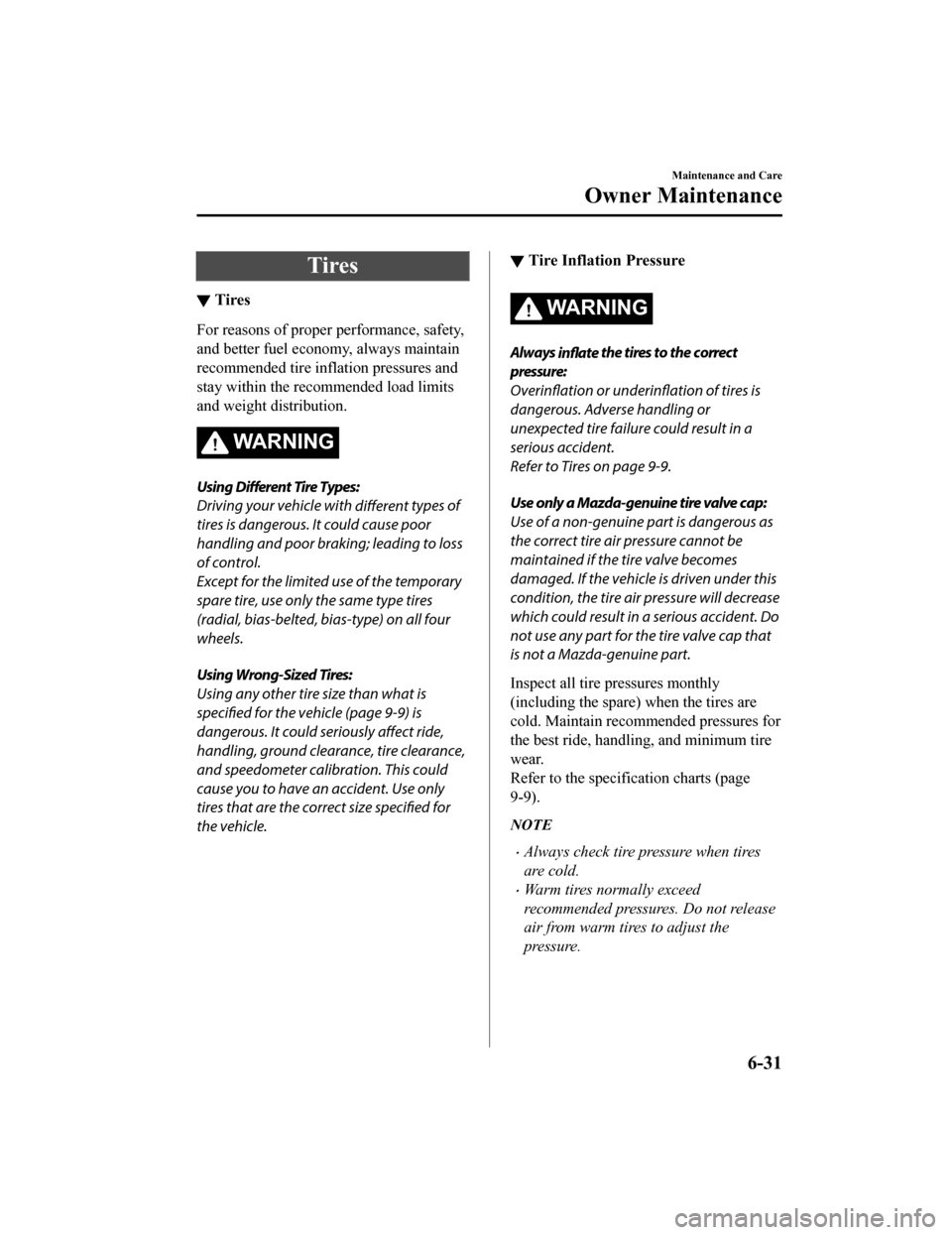
Tires
▼Tires
For reasons of proper
performance, safety,
and better fuel economy, always maintain
recommended tire inflation pressures and
stay within the recommended load limits
and weight distribution.
WA R N I N G
Using Different Tire Types:
Driving your vehicle with different types of
tires is dangerous. It could cause poor
handling and poor braking; leading to loss
of control.
Except for the limited use of the temporary
spare tire, use only the same type tires
(radial, bias-belted, bias-type) on all four
wheels.
Using Wrong-Sized Tires:
Using any other tire size than what is
specified for the vehicle (page 9-9) is
dangerous. It could seriously affect ride,
handling, ground clearance, tire clearance,
and speedometer calibration. This could
cause you to have an accident. Use only
tires that are the correct size specified for
the vehicle.
▼ Tire Inflation Pressure
WA R N I N G
Always
inflate the tires to the correct
pressure:
Overinflation or
underinflation of tires is
dangerous. Adverse handling or
unexpected tire failure could result in a
serious accident.
Refer to Tires on page 9-9.
Use only a Mazda-genuine tire valve cap:
Use of a non-genuine part is dangerous as
the correct tire air pressure cannot be
maintained if the tire valve becomes
damaged. If the vehicle is driven under this
condition, the tire air pressure will decrease
which could result in a serious accident. Do
not use any part for the tire valve cap that
is not a Mazda-genuine part.
Inspect all tire pressures monthly
(including the spare) when the tires are
cold. Maintain recommended pressures for
the best ride, handling, and minimum tire
wear.
Refer to the specification charts (page
9-9).
NOTE
Always check tire pressure when tires
are cold.
Warm tires normally exceed
recommended pressures. Do not release
air from warm tires to adjust the
pressure.
Maintenance and Care
Owner Maintenance
6-31
Mazda3_8HZ1-EA-19G_Edition1_old 2019-5-17 13:49:03
Page 466 of 598
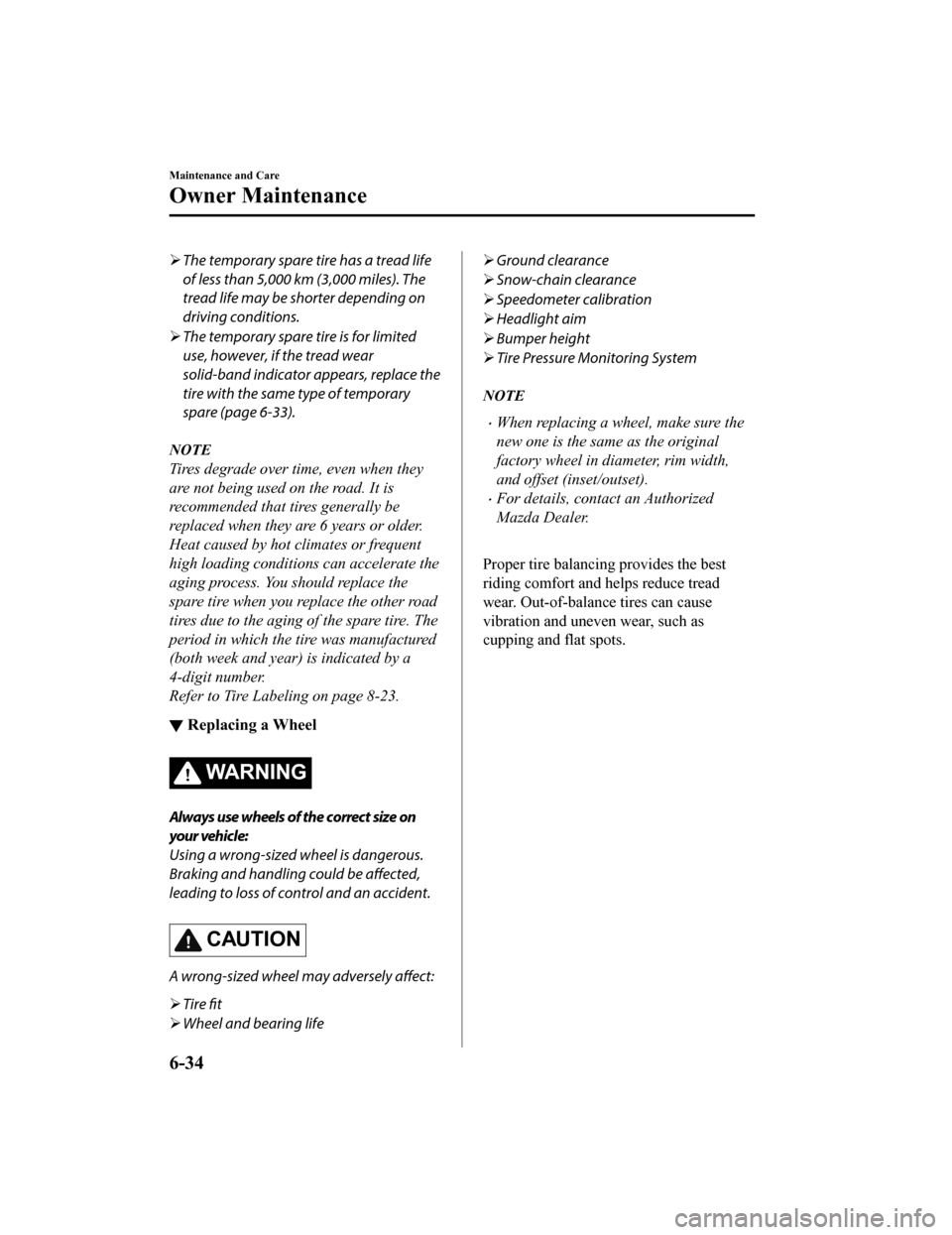
The temporary spare tire has a tread life
of less than 5,000 km (3,000 miles). The
tread life may be shorter depending on
driving conditions.
The temporary spare tire is for limited
use, however, if the tread wear
solid-band indicator appears, replace the
tire with the same type of temporary
spare (page 6-33).
NOTE
Tires degrade over time, even when they
are not being used on the road. It is
recommended that tires generally be
replaced when they are 6 years or older.
Heat caused by hot climates or frequent
high loading conditions can accelerate the
aging process. You should replace the
spare tire when you replace the other road
tires due to the aging of the spare tire. The
period in which the tire was manufactured
(both week and year) is indicated by a
4-digit number.
Refer to Tire Labeling on page 8-23.
▼ Replacing a Wheel
WA R N I N G
Always use wheels of the correct size on
your vehicle:
Using a wrong-sized wheel is dangerous.
Braking and handling could be affected,
leading to loss of control and an accident.
CAUTION
A wrong-sized wheel may adversely
affect:
Tire fit
Wheel and bearing life
Ground clearance
Snow-chain clearance
Speedometer calibration
Headlight aim
Bumper height
Tire Pressure Monitoring System
NOTE
When replacing a wheel, make sure the
new one is the same as the original
factory wheel in diameter, rim width,
and offset (inset/outset).
For details, contact an Authorized
Mazda Dealer.
Proper tire balancing provides the best
riding comfort and helps reduce tread
wear. Out-of-balance tires can cause
vibration and uneven wear, such as
cupping and flat spots.
Maintenance and Care
Owner Maintenance
6-34
Mazda3_8HZ1-EA-19G_Edition1_old 2019-5-17 13:49:03
Page 492 of 598

1. Park on a hard, level surface off theright-of-way and firmly set the parking
brake.
2. Put a vehicle with an automatic transmission in Park (P), a manual
transmission in Reverse (R) or 1, and
turn off the engine.
3. Turn on the hazard warning flasher.
4. Have everyone get out of the vehicle and away from the vehicle and traffic.
5. Remove the jack, tool, and spare tire
(page 7-3).
6. Block the wheel diagonally opposite the flat tire. When blocking a wheel,
place a tire block both in front and
behind the tire.
NOTE
When blocking a tire, use rocks or
wood blocks of sufficient size if
possible to hold the tire in place.
▼Removing a Flat Tire
WA R N I N G
When jacking-up a vehicle, always shift the
shift lever to 1st or R position (manual
transmission vehicle) or shift the selector
lever to P position (automatic transmission
vehicle), apply the parking brake, and place
wheel blocks in the position diagonally
opposed to the jack:
Changing a
flat tire without using wheel
blocks is dangerous because the vehicle
may move and fall off the jack even with
the shift lever in 1st or R position, or the
selector lever is in P position, which could
result in an accident.
1. If your vehicle is equipped with a wheel cover, pry off the wheel cover
with the beveled end of the jack lever.
NOTE
Force the end of the jack lever firmly
between wheel and cover, or removal
will be difficult.
If Trouble Arises
Flat Tire
7-8
Mazda3_8HZ1-EA-19G_Edition1_old 2019-5-17 13:49:03
Page 516 of 598

“AWD Malfunction. Front Wheel Drive
Only. Have the Vehicle Inspected” is
displayed/When the light is turned on
The indication is displayed/the light turns
on under the following conditions. The
system may have a malfunction. Have the
vehicle checked at an Authorized Mazda
Dealer.
When there is a malfunction in the
AWD system.
“Excessive AWD System Load. Drive
Slowly Until Warning Light Turns Off.
Vehicle Now in Front Wheel Drive” is
displayed/When the light is flashing
The indication is displayed/the light
flashes under the following conditions.
Park the vehicle in a safe place and check
that the warning indication light turns off/
the warning light stops flashing, and then
drive the vehicle. Contact an Authorized
Mazda Dealer if the indication is
continuously displayed.
When the differential oil temperature is
excessively high.
When there is a large difference between
the front and rear wheel rotation, such as
when trying to remove the vehicle from
mud.
“Mismatched Tire Diameters. Vehicle
Now in Front Wheel Drive” is
displayed/When the light is turned on
The indication is displayed/the light turns
on under the following conditions. Inspect
the tire sizes or tire pressures on all 4
wheels. Contact an Authorized Mazda
Dealer if the indication remains on or the
warning light remains illuminated.
When any of the tire diameter is
different.
When any of the tire pressure is
incorrect.
▼ TCS/DSC Indication/Indicator
Light (Turns on)
If the light stays on, the TCS, DSC or the
brake assist system may have a
malfunction and they may not operate
correctly. Take your vehicle to an
Authorized Mazda Dealer.
▼Air Bag/Front Seat Belt
Pretensioner System Warning
Indication/Warning Light
A system malfunction is indicated if the
warning light constantly flashes,
constantly illuminates or does not
illuminate at all when the ignition is
switched ON. If any of these occur,
consult an Authorized Mazda Dealer as
soon as possible. The system may not
operate in an accident.
If Trouble Arises
Warning/Indicator Lights and Warning Sounds
7-32
Mazda3_8HZ1-EA-19G_Edition1_old
2019-5-17 13:49:03
Page 557 of 598
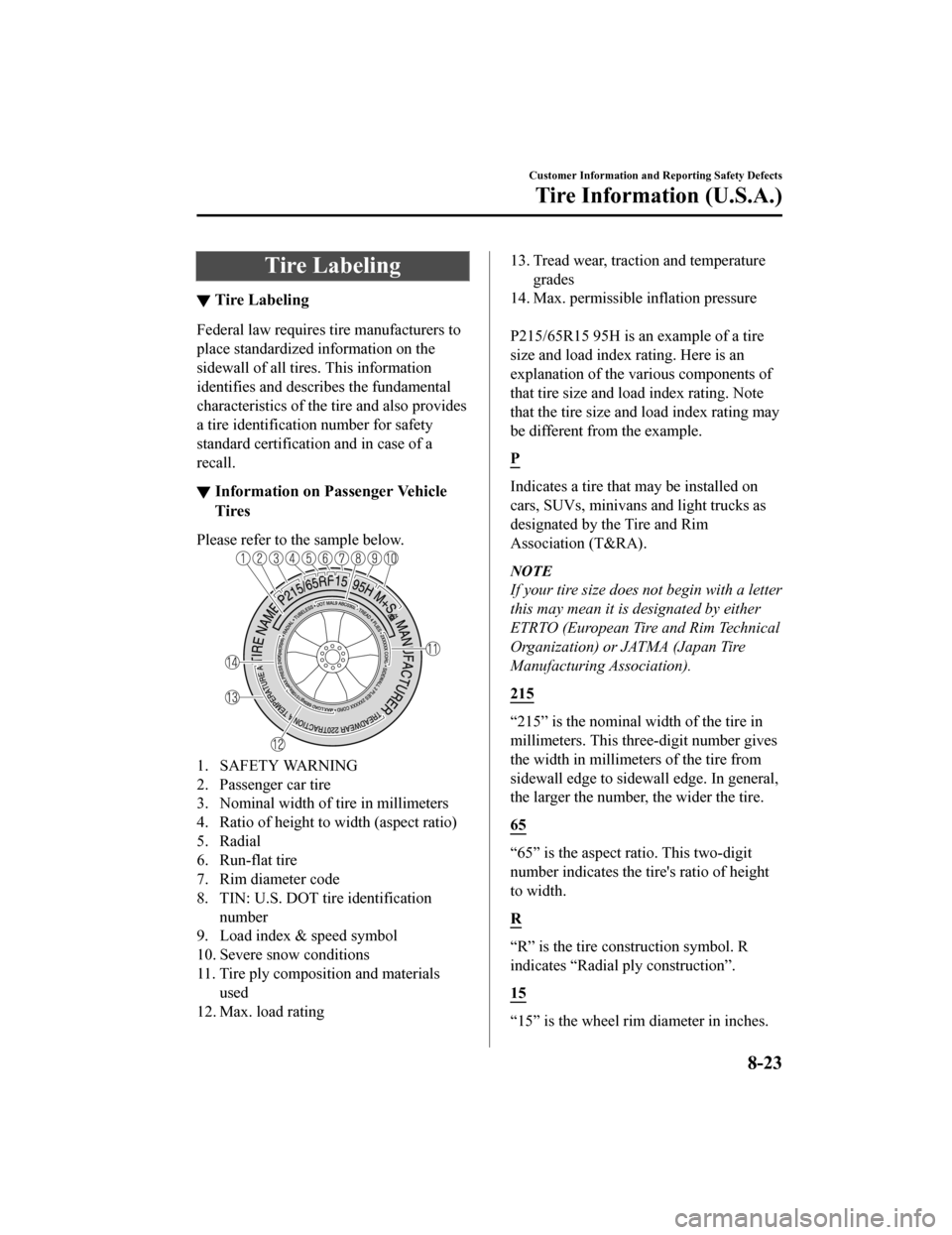
Tire Labeling
▼Tire Labeling
Federal law requires tire manufacturers to
place standardized information on the
sidewall of all tires. This information
identifies and describes the fundamental
characteristics of the tire and also provides
a tire identification number for safety
standard certification and in case of a
recall.
▼Information on Passenger Vehicle
Tires
Please refer to the sample below.
1. SAFETY WARNING
2. Passenger car tire
3. Nominal width of tire in millimeters
4. Ratio of height to width (aspect ratio)
5. Radial
6. Run-flat tire
7. Rim diameter code
8. TIN: U.S. DOT tir
e identification
number
9. Load index & speed symbol
10. Severe snow conditions
11. Tire ply composition and materials used
12. Max. load rating
13. Tread wear, traction and temperature grades
14. Max. permissible inflation pressure
P215/65R15 95H is an example of a tire
size and load index rating. Here is an
explanation of the various components of
that tire size and load index rating. Note
that the tire size and load index rating may
be different from the example.
P
Indicates a tire that may be installed on
cars, SUVs, minivans and light trucks as
designated by the Tire and Rim
Association (T&RA).
NOTE
If your tire size does not begin with a letter
this may mean it is designated by either
ETRTO (European Tire and Rim Technical
Organization) or JATMA (Japan Tire
Manufacturing Association).
215
“215” is the nominal w idth of the tire in
millimeters. This three-digit number gives
the width in millimeters of the tire from
sidewall edge to sidewall edge. In general,
the larger the number, the wider the tire.
65
“65” is the aspect ratio. This two-digit
number indicates the tire's ratio of height
to width.
R
“R” is the tire construction symbol. R
indicates “Radial ply construction”.
15
“15” is the wheel rim diameter in inches.
Customer Information and Reporting Safety Defects
Tire Information (U.S.A.)
8-23
Mazda3_8HZ1-EA-19G_Edition1_old 2019-5-17 13:49:03
Page 559 of 598
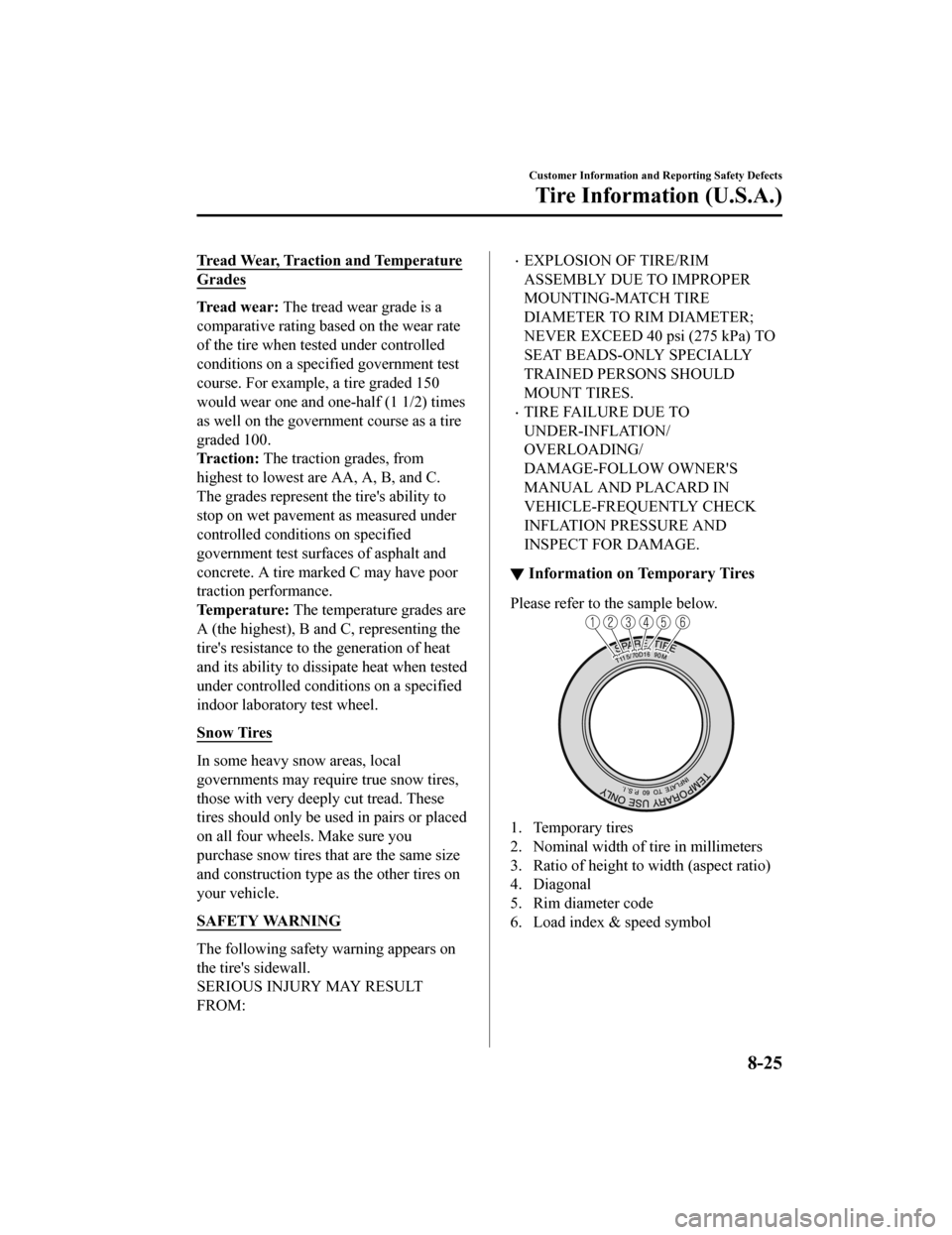
Tread Wear, Traction and Temperature
Grades
Tr e a d w e a r : The tread wear grade is a
comparative rating based on the wear rate
of the tire when tested under controlled
conditions on a specified government test
course. For example, a tire graded 150
would wear one and one-half (1 1/2) times
as well on the government course as a tire
graded 100.
Traction: The traction grades, from
highest to lowest are AA, A, B, and C.
The grades represent the tire's ability to
stop on wet pavement as measured under
controlled conditi ons on specified
government test surfaces of asphalt and
concrete. A tire marked C may have poor
traction performance.
Temperature: The temperature grades are
A (the highest), B and C, representing the
tire's resistance to the generation of heat
and its ability to dissipate heat when tested
under controlled conditions on a specified
indoor laboratory test wheel.
Snow Tires
In some heavy snow areas, local
governments may require true snow tires,
those with very deeply cut tread. These
tires should only be used in pairs or placed
on all four wheels. Make sure you
purchase snow tires that are the same size
and construction type a s the other tires on
your vehicle.
SAFETY WARNING
The following safety warning appears on
the tire's sidewall.
SERIOUS INJURY MAY RESULT
FROM:
EXPLOSION OF TIRE/RIM
ASSEMBLY DUE TO IMPROPER
MOUNTING-MATCH TIRE
DIAMETER TO RIM DIAMETER;
NEVER EXCEED 40 psi (275 kPa) TO
SEAT BEADS-ONLY SPECIALLY
TRAINED PERSONS SHOULD
MOUNT TIRES.
TIRE FAILURE DUE TO
UNDER-INFLATION/
OVERLOADING/
DAMAGE-FOLLOW OWNER'S
MANUAL AND PLACARD IN
VEHICLE-FREQUENTLY CHECK
INFLATION PRESSURE AND
INSPECT FOR DAMAGE.
▼ Information on Temporary Tires
Please refer to the sample below.
1. Temporary tires
2. Nominal width of tire in millimeters
3. Ratio of height to width (aspect ratio)
4. Diagonal
5. Rim diameter code
6. Load index & speed symbol
Customer Information and Reporting Safety Defects
Tire Information (U.S.A.)
8-25
Mazda3_8HZ1-EA-19G_Edition1_old
2019-5-17 13:49:03
Page 560 of 598

T115/70D16 90M is an example of a tire
size and load index rating. Here is an
explanation of the various components of
that tire size and load index rating. Note
that the tire size and load index rating may
be different from the example.
T
Indicates a tire that may be installed on
cars, SUVs, minivans and light trucks as
designated by the Tire and Rim
Association (T&RA).
11 5
“115” is the nominal w idth of the tire in
millimeters. This three-digit number gives
the width in millimet ers of the tire from
sidewall edge to sidewall edge. In general,
the larger the number, the wider the tire.
70
“70” is the aspect ratio. This two-digit
number indicates the tire's ratio of height
to width.
D
“D” is the tire construction symbol. D
indicates “diagonal ply construction”.
16
“16” is the wheel rim diameter in inches.
90
“90” is the Load Index. This two-or
three-digit number indicates how much
weight each tire can support.
M
“M” is the speed rating. The speed rating
denotes the maximum speed for which the
use of the tire is rated.
Letter Rating Speed Rating M8 1 m ph
Customer Information and Reporting Safety Defects
Tire Information (U.S.A.)
8-26
Mazda3_8HZ1-EA-19G_Edition1_old 2019-5-17 13:49:03
Page 561 of 598

Location of the Tire Label(Placard)
▼Location of the Tire Label (Placard)
You will find the tire
label containing tire
inflation pressure by tire size and other
important info rmation on the driver's side
B-pillar or on the edge of the driver's door
frame.
SAMPLE
▼ Recommended Tire Inflation
Pressure
On the tire label you will find the
recommended tire inflation pressure in
both kPa and psi for the tires installed as
original equipment on
the vehicle. It is
very important that the inflation pressure
of the tires on your vehicle is maintained
at the recommended pressure. You should
check the tire pressure regularly to insure
that the proper inflation pressure is
maintained.
Refer to Tires on page 9-9.
NOTE
Tire pressures listed on the vehicle placard
or tire information label indicate the
recommended cold tire inflation pressure,
measured when the tires are cold, after the
vehicle has been parked for at least 3
hours. As you drive, the temperature in the
tire warms up, increasing the tire pressure.
WA R N I N G
Always check the tire inflation pressures on
a regular basis according to the
recommended tire inflation pressure on the
tire label and in conjunction with the
information in this owner's manual:
Driving your vehicle with under-inflated
tires is dangerous.
Under-inflation is the most common cause
of failures in any kind of tire and may result
in severe cracking, tread separation or
“blowout”, with unexpected loss of vehicle
control and increased risk of injury.
Under-inflation increases sidewall
flexing
and rolling resistance, resulting in heat
buildup and internal damage to the tire. It
results in unnecessary tire stress, irregular
wear, loss of control and accidents. A tire
can lose up to half of its air pressure and
not appear to be flat!
It is impossible to determine whether or not
tires are properly inflated just by looking at
them.
▼ Checking Tire Pressure
1. When you check the air pressure, make
sure the tires are cold ―meaning they
are not hot from driving even a mile.
2. Remove the cap from the valve on one
tire.
3. Firmly press a tire gauge onto the
valve.
4. Add air to achieve recommended air pressure.
5. If you overfill the tire, release air by
pushing on the metal stem in the center
of the valve. Then recheck the pressure
with your tire gauge.
6. Replace the valve cap.
Customer Information and Reporting Safety Defects
Tire Information (U.S.A.)
8-27
Mazda3_8HZ1-EA-19G_Edition1_old 2019-5-17 13:49:03
Page 562 of 598

7. Repeat with each tire, including thespare.
NOTE
Some spare tires require higher
inflation pressure.
8. Visually inspect the tires to make sure
there are no nails or other objects
embedded that could poke a hole in the
tire and cause an air leak.
9. Check the sidewalls to make sure there are no gouges, cuts, bulges, cracks or
other irregularities.
▼Glossary of Terms
Tire Placard:
A label indicating the OE
tire sizes, recommended inflation pressure,
and the maximum weight the vehicle can
carry.
Tire Identification Number (TIN): A
number on the sidewall of each tire
providing information about the tire brand
and manufacturing plant, tire size, and
date of manufacture.
Inflation Pressure: A measure of the
amount of air in a tire.
kPa: Kilopascal, the metric unit for air
pressure.
psi: Pounds per square inch, the English
unit for air pressure.
B-pillar: The structural member at the
side of the vehicle behind the front door.
Original Equipment (OE): Describes
components originally equipped on the
vehicle.
Vehicle Load Limit: The maximum value
of the combination weight of occupants
and cargo.
Bead Area of the Tire: Area of the tire
next to the rim.
Sidewall Area of the Tire: Area between
the bead area and the tread.
Tread Area of the Tire: Area on the
perimeter of the tire t hat contacts the road
when it's mounted on the vehicle.
Seating capacity means the total
allowable number of vehicle occupants.
Seating capacity is described on the tire
label.
Production options weight is the
combination weight of installed regular
production options weighing over 2.3
kilograms in excess of the standard items
which they replace, and not previously
considered in the curb weight or accessory
weight, including heavy duty brakes, ride
levelers, roof rack, heavy duty battery, and
special trim.
Rim is the metal support (wheel) for a tire
or a tire and tube assembly upon which the
tire beads are seated.
Customer Information and Reporting Safety Defects
Tire Information (U.S.A.)
8-28
Mazda3_8HZ1-EA-19G_Edition1_old 2019-5-17 13:49:03